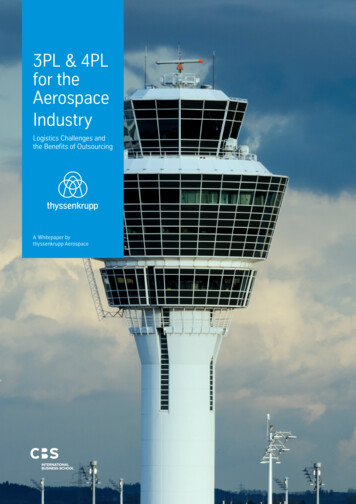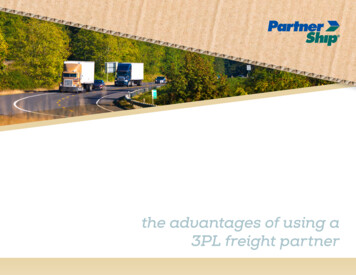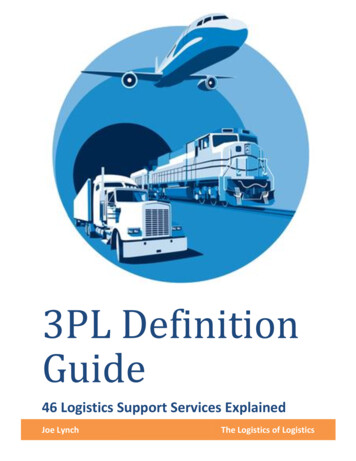
Transcription
3PL & 4PLfor theAerospaceIndustryLogistics Challenges andthe Benefits of OutsourcingA Whitepaper bythyssenkrupp Aerospace
2IntroductionWhy Logistics Partners‘ InvolvementCould Make all the DifferenceWhat is 4PL & 3PL?Third-party logistics (3PL) describes a company’suse of outsourcing partners to manage parts oftheir warehousing, transport or fulfilment processes. Those 3PL logistics service providers usuallyspecialize in separate integrated logistics operations and include for example freight forwardingcompanies.Fourth-party logistics (4PL) takes the 3PLoutsourcing concept further by managing entirenetworks including e.g. various 3PL companies,resources or locations to develop and maintainfully integrated and optimised supply chain solutions. Even strategic supply chain consulting ispossible. A special concept connected with 4PLis the Lead Logistics Provider (LLP), which usuallyconsists of a control tower operation from whichthe provider manages (parts of) the company’ssupply chain network.ActorsServices11PL522PL6343PL4PL1234Cargo OwnersCarriersLogistics Service ProvidesLead Logistics Providers &Consultants5678Manufacturing, RetailingTransportationLogisticsSupply Chain ManagementSource: supplychain247.com78Global trade and transport volumes have been growing rapidly forseveral decades. In recent years also the outsourcing of supplychain functions to different kinds of logistics service providers hasbecome vital to improve top- and bottom-line results. Therefore,the make-or-buy decision – i.e. to maintain logistics functionsinternally or to (sub-)contract them externally to partners – is a critical strategic consideration for companies. It has significantimpacts on sustaining organisational competitiveness. And theaerospace industry is no exception.In fact, aerospace supply chains are confronted with industry-specific challenges: In commercial aerospace, the long-term competitive outlook is forcing companies to manufacture new & improvedproducts more frequently. In defense, the market is returning togrowth after nearly a decade of declining defense budgets. Thesecases demand greater investments in development, capital expenditures, and inorganic growth opportunities.1234Are there any existing solutionsto meet those challenges?Can we spot trends that alreadyshape the industry?How important are 3PL and 4PLfor global supply chains?And what should companies knowwhen choosing their externalservice partners?The following whitepaper seeks to answer these questions. It discusses solutions and trends, which are set to overcome concurrentchallenges. The publication focusses on the potential roles of logistics providers (3PL, 4PL) in the aerospace industry and presentsa case study for successful logistics partnering.
3Background & ResponseRisks & challengesfor Supply ChainsCompanies must deal with fluctuations in global demand,exchange rates or key commodity prices such as oil. Globalization and increasing uncertainties provide constraints. Intimes of VUCA1 companies are faced with a high variety ofchallenges that have to be managed. Typical risks andchallenges for supply chains include:Technology & business disruptions encouraged by constantly increasing customer requirements in terms of price,safety, quality, speed etc. & consequently ever shorterlife cycles combined with higher product rangesIncreasing dependencies & complexities from internal &external areas such as processes, networks or spare partvarieties or bottle-necks & operational inefficiencies caused by tier-x supplier shortages etcSolutions & Trendsin the Supply ChainIndustryNot surprisingly, the digital transformation is also a major disruptor in the supply chain industry. Concepts such as Logistics4.0 are no longer buzzwords but provide proven benefits forsupply chains across all industries.The industry is successfully applying technologysolutions such as IoT devices, cloud services orbig data and predictive analytics.Automation or innovations are already providingfascinating business cases like autonomous logisticsvehicles, AI support, exoskeletons or 3D printing.“Open Data” concepts as well as crowdsolutions and strategic collaborations arealso at the centre of attention.Fragmentation of ownerships in supply chains dueto outsourcing: Companies can benefit from partnercompetencies, but less vertical integration resultsin new requirements for strategic alignments acrossdifferent external parties. This leads to resourceconsuming orchestration efforts.Sustainability & environment: Not only considering increasingly extreme weather events that are occurring & disrupting SCs, sustainability across the different SC partnersbecomes criticalAdditional risks such as fraud, geopolitical challenges,terrorism, strikes or cyber- and bio-threats are findingan easy access to supply chains due to e.g. outdatedand inflexible IT systems or inefficient data andcommunication processes.1VUCA is an acronym to describe four distinct types of challenges that companies haveto respond to in today’s world-markets. The four letters stand for volatility, uncertainty,complexity, and ambiguity. Further reading: Bennett, N., Lemoine G.J. (2014):What VUCA Really Means for You, HBR.Outsourcing is a relevant factor. 3PL revenues grew to869 billion Dollar in 2017 from 804 billion Dollar yoy,resulting in a worldwide growth of 8.1 percent yoyacross all major regions2.Approximately 90 percent of the interviewed 3PL clients instudy from Korn Ferry report that the partnerships havebeen successful and that the usage of 3PL services contributed to improving the service quality for theirend-customers.All this makes it a necessity for companies to internally andexternally integrate their supply chain processes and developindividual solutions to their specific challenges – often togetherwith 3PL or 4PL logistic service providers.2Korn Ferry (2019): Third-Party Logistics Study.
4OutsourcingThis Could be Your Benefits fromLogistics OutsourcingOptimised informationflow & (order) managementshould accordingly reducedelays & cycle-/lead-timesMore reliable & integrated datamanagement should lead to e.g.higher inventory & stock processing accuracyIncreased SC securityvia alternative supply sources ortransport options & sharing ofrisks such as ForExEfficiency in operations & theelimination of waste &inefficienciesValuable insightsinto state-of-the art logistics &develop a competitive advantageMore agile & dynamic SCin order respond quickly incase of uncertainties (betterSC contingency management)Forecasting/planning competencies & sharing experiencesaround e.g. port operations orcustoms delaysA positive impact on thecompany’s financial performancesuch as an increase in (inventory)turnover is a common result.So, what can you expect from a logistics outsourcing project& what are reasons why so many companies engage in sucha strategic partnership? There have been various studies3 thatconducted research on the implications & benefits of logisticsoutsourcing that go well beyond the typical contributions as improved performance in the operations via reduced logistics costs orimproved (end-)customer service.3Cf. e.g. Arif, J., Jawab, F. (2018): Outsourcing of Logistics’ Activities:Impact Analysis on Logistics Service PerformanceCompetitiveness andproductivity gainscan best be captured bya supply chain partnershipapproach.
5How to succeedwith LogisticsOutsourcingLogistics outsourcing has a positive impact on the company’sfinancial performance. However, a supply chain partnershipalso contains risks. Therefore, the following section providesrecommendations for an optimal outsourcing outcome.Background Advantages& ResponseQuality and reliability are key criteria.Therefore, review certifications and trackrecords of the company. Ask for referencesand contacts from other existing clientsEfficiency should be in focus.Is the provider able to drive cost reductionand continuous optimizations?Develop a thorough contract that outlinesagreed specifications and clear ServiceLevel Agreements (SLAs) such as expectedlead-times with clearly defined escalationprocesses and implications ofnon-conformance.Seek strategic alignment: Both partiesshould have similar long-term ambitionsand commitments for the partnership.Consider e.g. what kind of managementlevel is involved.You have a strategic choice between 3PL or 4 PL partners. Butthe two concepts are not always clearly distinguishable. Therecommendations apply to both options.If you opt for a 4PL partner, be aware that the provider is atthe heart of the supply chain and acts as a central coordination point between various (logistics) partners. Therefore, theprovider should ensure to offer neutral and independent services. Also, the company should have special skills in orderto continuously supply value-based optimizations across thesupply chain.So theoretically, we know which qualities a 3PL or 4PL serviceprovider should have. But how does that look in practice? Docertain characteristics really contribute to successful logisticsoutsourcing? Does this help to achieve the advantages ofcooperation with external partners? And can efficiency gainsbe verified in figures?Let‘s look at a real case: thyssenkrupp Aerospace, a proven3PL and 4PL partner, supports Rolls-Royce in optimizing theirsupply chain for aircraft engine components.Make sure, the outsourcing partner iswilling to expand the operations andinvest in the partnership.This links well with the requiredresponsiveness to cope with possibleuncertainties in the future.Consider changing logistics needs andthe portfolio of your chosen provider.Are special solutions supported?
6Case StudyRolls-Royce or The Value of Workingwith thyssenkrupp AerospaceAs 3PL and 4PL partner, thyssenkruppAerospace has all the qualities a serviceprovider should have. Its global presenceand network of 44 locations in around 22countries is a key advantage. It allows closecooperation with customers, who benefitfrom the in-depth appreciation of their specific needs as well as from global logisticsinfrastructure and broad expertise.CanadaUnited StatesBrazilUnited outh KoreaHong KongIndiaSingapore
7Case StudyChallengesProjectsImplementationthyssenkrupp Aerospace has experience indeveloping and implementing solutions forthe specific logistics challenges of theaerospace industry. Typically, the industrybattles withNot all of the challenges mentioned aboveapply to the customer Rolls Royce, whotasked thyssenkrupp Aerospace with optimizing its supply chain for aircraft enginecomponents. More specifically, the customer’s goal was to increase the materialflow and reduce inventory throughout itssupply chain while enabling overhead costreduction. Pain points to solve includedAs mentioned in the paragraph “How toSucceed with Logistics Outsourcing”, it isextremely important for the 3PL or4PLpartner to be able to react to changingand developing requirements. This wasalso a relevant issue in the cooperationbetween thyssenkrupp Aerospace andRolls-Royce.unnecessarily highprocurement costsstockpiling that tiesup enormous amountsof capitala 5 to 10 percent transportcost share of procurement costshigh levels of working capitalexpensive finished partsa high percentage of lost ordamaged partsIt initially started out on a small scale, withthe specific objective of designing a VMIsupply chain solution. This design laterdeveloped into a 3PL Request for Proposal(RFP) which thyssenkrupp Aerospace subsequently bid on and won. Over the courseof several years, we implemented thechanges with a phased approach addingmore suppliers and part numbers.excessive expedite costs.difficulties with suppliesdelayed production starts,reworking in series productionor recallscompliance failures,resulting in possible finesThese challenges required individual solutions, tailored to the company‘s supplychain.In the end, a highly corroborative,cross-functional team of experts hadaddressed all aspects of the project, fromlogistics, supplier quality, and purchasingto finance, IT and transportation. Businessimprovement and quality assurance werecentral matters. In short: The 3PL partnerestablished an integrated services valuestream between suppliers and Rolls-Royce,concerning inspection, storage, kitting/packing, and POU delivery.
8Case StudyRolls-Royce or The Value of Workingwith thyssenkrupp AerospaceYourchallengesthyssenkruppsolutionsYour valueCosts that occur to replaceStuck and slow processesthousands of m2 space fullof parts and materialsHaving the right parts, in theright place, at the right timeInspection service &Quality TestingPackaging & kittingWarehousing ServicesDirect line deliveryof kitted partsVendor ManagedInventory storageFull barcodeidentificationCost avoidance &ReliabilityFaster and leanerprocessesReduced floor spacefootprintReliable productionplanning with ensuredsupplyFocus on corecompetenceIncreased capitalavailabilityDemand ManagementImproved metrics andreports forstakeholdersCash not tied up inoboslete or overstockedinventory
9Case StudyResultsTo put a number on it, the 3PLpartnership resulted in:a reduction of200,000 SAPtransactions per year yielding3.5 million annual costatwo-million-dollarinventory dfrom entering facilities(compared to 4600 parts)part numbers shipping fromapproximately 180 suppliers(compared to 80)no delaysinventoryinformationwell-positionedreadily availableto assembly or customerorganization for flow line kittingThe advantages for the customer include, of course, general benefits such as improvedperformance in the operations via reduced logistics costs, and – last but not least – anaccess to logistic know-how that a partner like thyssenkrupp Aerospace can provide.
10Key RecommendationsTakeaways for Supply Chain Optimizationwith Strategic Partners1External partners contribute valuable know-how fordata analytics, solid IT tools or process optimisations –all those things you need to lay a solid foundation for improvementsand increase the flexibility of your supply chain. In the end, that is amajor factor for profitable und sustainable growth.2Companies need to further optimise theircosts and enhance their efficiencies.Together with the requirement for greater flexibility, this is a difficult task.That means, your supply chain is tailored to be efficient but also future-fitand adaptable for coping with ever-changing circumstances. Supply chainoutsourcing can be a valuable support in this regard.3There is no simple one-size-fits-all solution.So, external partners support you by individually examining and developingon a case-specific basis. Experience proves that it pays off to focus onselected processes, high-level objectives as well as key flows first.4The human factor remains a key element for supply chain success,both for internal and external stakeholders. Yet technological approaches tooptimise supply chains are a trend where partners can provide intelligent support.5Competition and competitiveness affect the supply chain includingall partners and suppliers, not just the company itself.Therefore, a holistic assessment of all potential vulnerabilities along theentire supply chain network should be executed. The goal is to enhancethe overall supply chain resilience and robustness.6Learning together for the future!External supply chain experts can be a valuable source for theidentification of past bottleneck situations and supplier disruptions.7You can‘t really go wrong with a strategic partnership.An experienced and reliable logistics service provider helps to tacklesupply chain challenges and opens up opportunities from outsourcing.This partner should be aware of your industries’ specific challenges.
11Background &ImpressumResponseAbout the AuthorsProf. Dr. Nils FingerProf. Dr. Nils Finger is a professor of Supply ChainManagement at CBS International BusinessSchool. He links relevant theories from his studiesin Germany, Australia, Hong Kong & England withbest practices from his work experience in industries such as automotive, high-tech & telecommunications. As Vice President for Innovation & Academic Affairs at his university, his current researchfocuses on innovations, digital transformations aswell as sustainability in supply chains.Do you need a strategic partner foryour 3PL and 4PL logistics? Or doyou want to learn more about theadvantages of logistics outsourcing?The thyssenkrupp Aerospace teamwill get in touch with you:aerospace@thyssenkrupp.comThomas PingenThomas Pingen holds a Master in Engineering forProduction Technologies and a Master in Economics focussing on Supply Chain Management. Inhis role at thyssenkrupp Aerospace he is responsible for Customers, Markets and Developmentand strives together with the entire thyssenkruppAerospace organization to develop customizedSupply Chain solutions providing specific andmeasurable values to all its customers.
products more frequently. In defense, the market is returning to growth after nearly a decade of declining defense budgets. These cases demand greater investments in development, capital expen - ditures, and inorganic growth opportunities. 7 The following whitepaper seeks to answer these questions. It dis -










